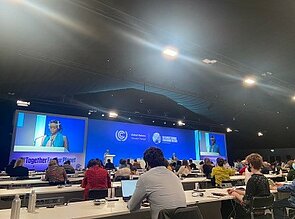Impressions from the 26th Climate Change Conference (COP26) Paris mechanism is working, but the +1.5°C limit is a long way off as climate impacts come to the fore
Impression from the conference center ©R. Mechler
Civil society action in Glasgow ©R. Mechler
Reinhard Mechler (IIASA) and Sarah Louise Nash (BOKU)
The 26th Climate Change Conference brought thousands of negotiators from North and South, a strong representation of civil society, international institutions, the private sector and research to Glasgow, despite corona-related restrictions and access limitations for some participants - although the strong presence of the fossil fuel industry was strongly criticized. After Ausfall 2020, the mixed physical and virtual meeting was the first climate conference at which provisions of the Paris Agreement adopted in 2015 replaced commitments under the Kyoto Protocol.
The aim of the Paris Agreement is to limit the global temperature rise to ideally +1.5°C, but no more than +2°C degrees (compared to pre-industrial levels), to ensure appropriate adaptation and climate impact mitigation measures, as well as to generate funding to benefit particularly vulnerable countries and communities.
The conference was an important test of whether the cooperation agreed under the Paris Agreement is working in a complex and hard-hit world that has already warmed by +1.1°C and is clearly feeling the effects of climate change. The two-week intensive exchange and the agreed final agreement (Glasgow Climate Pact) show that the Paris Agreement is having an impact, that the need to limit global warming to +1.5°C is clear to all participants and Paris Parties, but that implementation is still inadequate and needs to be significantly strengthened - with the help of evidence-based science.
What was achieved?
Rhetorically, the Glasgow meeting was a clear success. In negotiations, workshops and informal exchanges, there was broad agreement that the climate crisis is becoming increasingly existential, that transformations in climate protection and adaptation are necessary, and that solidarity and climate justice must be central principles in the fight against climate change. The phasing out of fossil fuels was also explicitly mentioned for the first time in a final document.
There is great awareness of the need to achieve the +1.5°C target, as the final document confirms in three paragraphs. Climate-related events in recent months and scientific reports by the Intergovernmental Panel on Climate Change (IPCC) and the Austrian Panel on Climate Change (APCC) have shown that the effects of climate change are already having a massive impact on life and limb; and, beyond +1.5°C, there are imponderable and existential risks, such as a sharp increase in heat waves, further sea-level rise, the spread of droughts and the loss of unique oceanic and terrestrial ecosystems.
Greenhouse gas mitigation-first effect of the Paris Agreement
The Paris Agreement requires its signatories to submit national greenhouse gas mitigation and adaptation targets every 5 years through Nationally Determined Contributions (NDC) reports with the following logic. Parties prepare NDCs, which are peer-reviewed by other countries in terms of necessary national ambition and joint achievement of the +1.5°C target in accordance with the Paris Agreement; the targets are then to be tightened over further reporting periods. This reporting process is mandatory with clear rules, but Paris does not provide for any binding targets. A great deal therefore depends on confidence-building and cooperation.
All signatory states have indeed submitted NDCs to date. Shortly before and during the negotiations in Glasgow, the targets were also tightened up even further: India, for example, promised to achieve net zero emissions for the first time - by 2070. As climate protection and adaptation are always global tasks, major global initiatives were also launched in Scotland to protect forests and reduce methane emissions.
The Paris Agreement appears to be having an impact, but the promised reductions (pledges) are far from sufficient and are subject to great uncertainty. According to estimates by the Climate Action Tracker, implementation of the current NDC plans would result in global warming of around +2.4°C (range +1.9°C to +3.0°C) by 2100 compared to an estimated warming of around +2.7°C (2.2°C to 3.4°C) with current measures. However, these projections are very uncertain as they assume full implementation of all proposed measures and concrete plans for the time horizon beyond 2030 are mostly missing. Various studies also assume much higher warming rates.
Adaptation to climate impacts and risks come to the fore
In the context of the worsening climate crisis, climate impacts, risks and adaptation were very much to the fore in Glasgow, also reinforced by many civil society actions before and within the conference center, which succinctly pointed out current and future impacts.
Civil society action in Glasgow
The role of adaptation was strengthened, both in targeting and supporting vulnerable countries in the Global South. The doubling of the Adaptation Fund was agreed and the previously missed target of $100 billion in funding for climate change mitigation and adaptation annually for non-industrialized countries was confirmed. Plans have been agreed to deliver the promised amounts for the period 2020-2025, with the pledges being a mix of additional mitigation and adaptation funding, loans and reallocated development cooperation funds. A process for long-term financing for adaptation measures from 2025 onwards was also agreed.
Beyond the limits of adaptation
However, it is clear that adaptation cannot completely reduce climate risks and that there are limits to adaptation. In Glasgow, countries from the global North and South confronted each other on how to deal with the impacts that have occurred and those that will occur, which are negotiated under the heading of loss and damage (climate-related damage and losses). The G77+China bloc and civil society have been vehemently calling for additional funds to deal with climate-related impacts for several years. While the global South in Glasgow called for a clear institutional basis and a fund for financial support and compensation for damage, the global North was only prepared to continue the dialog. However, there was agreement on the next steps for technical cooperation by means of a new network institution (Santiago Network for Loss&Damage).
In Glasgow, the topic gained momentum after Scotland's First Minister Nicola Sturgeon put £1 million of funding for such climate-related damage on the table at the beginning of the negotiations, only to increase this to £2 million at the end, with the Belgian region of Wallonia and an international coalition of philanthropists adding €4 million towards the end of the meeting. These pledges, although symbolic, were in part made for the first time by state actors in industrialized countries and may bring further movement to a complex negotiation matter.
Further strengthening science for ambition
The role of science has been very clearly confirmed after years of organized doubt about climate change and its impacts by a few influential states. The first chapter of the Glasgow Declaration reinforces the central role of science in identifying the risks and impacts of climate change, possible mitigation strategies, as well as measures to prevent and manage the necessary adaptation. As the consensus document of the approximately 200 negotiating states further states, this applies in particular to the coming years and the 'critical' decade of the 2020s, in which the +1.5 target must be achieved by means of knowledge-based transformation pathways, as well as adaptation and risk management strategies must be implemented. IPCC climate reports on risks and adaptation in February 2022 and on mitigation in March will serve as an important basis for further negotiations in 2022 and beyond.
As a negotiator, Austria was very active as a member of the EU negotiating bloc and also led the difficult negotiations on emissions trading for the EU within the framework of the Paris Agreement. Important progress was made in the negotiations, although some potential loopholes could not be completely closed. After initial hesitations due to questions about the role of nuclear power in climate protection (as rejected by Austria), Austria also became involved as part of the so-called High Ambition Coalition, which was launched by the Marshall Islands and includes countries from the global North and South.
To-dos for Austria
As a signatory to the High Ambition Coalition in Glasgow, it is now also important for Austria to take on an effective pioneering role internationally when it comes to climate protection, adaptation and dealing with the consequences of climate change. Once again, every effort must be made to comply with the +1.5°C target. The responsibility of the G20 countries, which together could limit global warming to +1.7°C by 2100, is also emphasized. This should also build up international pressure to tighten the NDCs by COP27. Particularly relevant for Austria are, among other things, the stipulated efforts to stop inefficient subsidies for fossil fuels as quickly as possible, although it remains unclear what the signatories mean by this (with the exception of coal production). In addition, methane emissions are to be reduced by at least 30% by 2030 compared to 2020 and the reduction of emissions in the transportation sector is also underpinned in the consensus document. Furthermore, funding for vulnerable countries should also be increased and these countries should be given support in difficult negotiations. As a high-emission country, Austria must now actively face up to its responsibility in tackling the climate crisis and quickly initiate further effective measures. Some progress has been made in recent weeks with CO2 pricing and the climate ticket, but this is not enough for the High Ambition Coalition. The Climate Protection Act, which expired in 2020, now needs to be renewed as quickly as possible by setting out concrete "roadmaps" for a trend reversal in climate protection.
Final showdown
Climate negotiations usually end with the adoption of a consensual agreement by the plenary of the member states, which sets out important agreements and intentions and looks to the future. The final plenary in Glasgow, as often in previous years, turned into a showdown. Although dissatisfied with many points (climate protection, financing, dealing with climate-related damage and loss), the states of the Global South were prepared to accept the final document in order to save the package knitted around the +1.5°C target. Much trust was then destroyed, especially among affected island states and representatives of Africa and South America, when the major emitters India and China forced the watering down of the coal phase-out in a last-minute backroom deal, reducing the ground-breaking formulation of the necessary global phase-out of coal energy (phasing out) to the vague phasing-in of the phase-out (phasing down). A minimal adjustment of the wording with potentially maximum impact on the 1.5°C target; there are currently 4,000 coal-fired power plants in operation worldwide, a large proportion of which would have to be closed according to calculations in order to give the +1.5°C climate target a good chance.
What remains?
Overall, another important, albeit insufficient, international step towards combating the climate crisis was taken in Glasgow. Ultimately, however, disappointment prevailed among (almost) all negotiators due to the inadequate outcome in climate protection, adaptation and coping with the impacts. Although, as suggested by some countries, the 'emergency' was not included in the title of the Glasgow Climate Pact final document, the climate crisis was omnipresent in and outside the conference halls. It is therefore important to further strengthen ambition and sharpen the NDCs, which will be presented and evaluated in 2022.
Because: the trend reversal is still a long way off. According to initial estimates, global greenhouse gas emissions rose sharply again in 2021, after falling for the first time ever in 2020 due to coronavirus. Globally, and also in Austria, there is a lot to do to reduce emissions and strengthen climate adaptation measures, as well as to support particularly affected countries and communities. The work of the negotiators and other stakeholders will continue after the conclusion of the negotiations in Glasgow through further meetings, negotiations and actions and must ensure that the +1.5° C target is kept in sight and that efforts to avoid greenhouse gases, adapt to climate change and cope with the consequences of climate change are massively increased.


